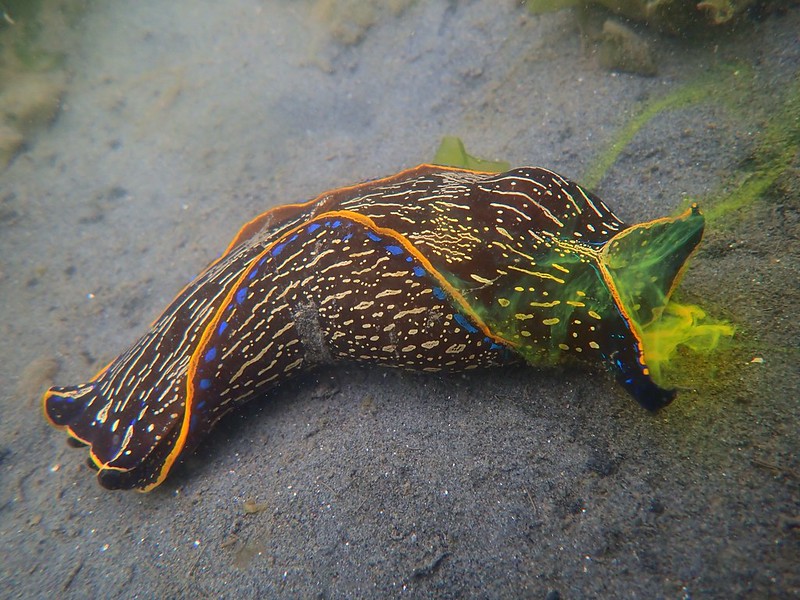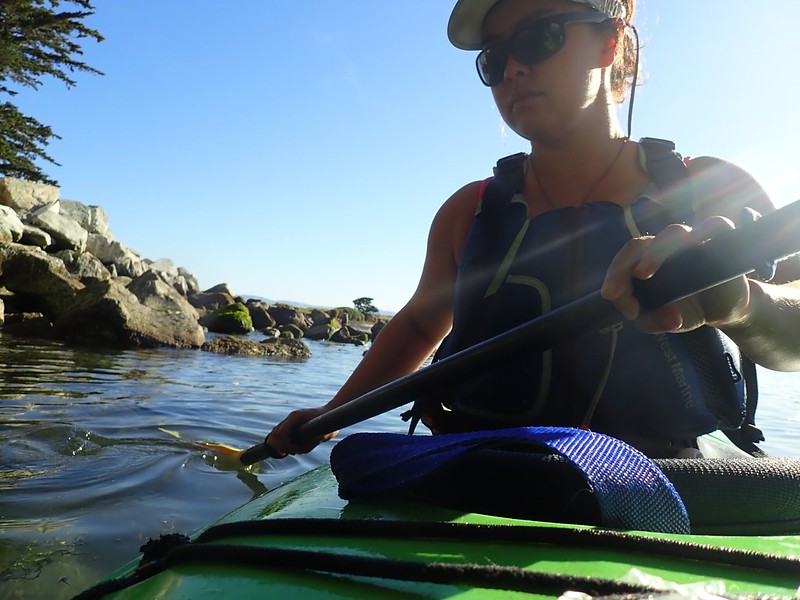Sea Slugs on the Elkhorn Slough - Observation of the Week, 7/7/19

Our Observation of the Week is this Navanax inermis sea slug, seen in the United States by lmkitayama!
“At work they call me the Slug Queen,” says Lauren Kitayama, an Assistant Manager at Kayak Connection in California. “Daylight permitting, I paddle once a week before work on the Elkhorn Slough. A couple of years ago, if you'd asked any of the local guides they might have said there were 5 species of sea slug on the slough. Last year I documented 27!”
The slug seen above was one of twenty Navanax inermis she spotted that morning, and said they were mating on the sea lettuce near the dock at work. “They are one of my favorite slugs,” she says,
They are large enough for people to appreciate, and so absolutely beautiful! I love using them to get people excited about the unloved slimy things that live in the ocean. One of my goals is always to show people something they never even imagined existed on the planet, and Navanax are a great opportunity to do that. As a kayak guide I work with a lot of school children, and love having the chance to inspire them to protect and appreciate the natural world around them.
While nudibranchs are the most commonly known order of sea slug, the Navanax inermis belongs to an entirely different order: Cephalaspidea, or the headshield slugs. Most members of this order, including the California Aglaja, do have a shell, but it is usually either tiny or internal. Navanax inermis are large slugs, growing anywhere from 2.5 to 10 inches (6.35 - 25.4 cm) in length, and they prey upon other gastropods and even small fish!

Lauren (above) earned a Masters in Marine Conservation from the University of Miami (FL), where she focused on the impacts of marine debris. “I am zealous about protecting the oceans from plastic...[and] someday I hope to work for the UN attacking the plastic pollution problem in Southeast Asia.” For now, however, she says she loves her current job, and tells me
My favorite thing is to see something I've never seen before. "I don't know" is my favorite answer to the question, "what is it?" I think that's how this whole slug thing started. They are beautiful, and most people would never look for them/see them without a guide. For whatever reason my slug observation skills are great. Can't find my keys half the time (or the sunglasses that are on my head), but a 9 mm sea slug hiding in a patch of kelp... no problem.
With my ecologist brain, I am excited to continue documenting slugs on the slough to see if a temporal pattern emerges (when are particular species showing up? Are they predictably in the same locations year after year?) I try very hard to get a photo of every species I see every week so that I can continue to document their presence/absence on the slough.
- by Tony Iwane.
- Check out Lauren’s Litter Mermaid projects and blog!
- And her sea slug observations.
- Watch a Navanax inermis eating a California Seahare.
- And watch a pair mating!





Comentarios
Wow! Gorgeous creature. As someone who spent 10 minutes today trying to photograph a micro-lep a few mm long I appreciate all the observers of the lesser-seen, the weird, the slimy and all of the stuff that should get more attention. Thanks for sharing. I'm sure we are all looking forward to species 28 :)
Love this! I have only spotted a California Aglaja once and been on the hunt ever since! Thanks for being such an inspiration to so many and keep the passion going :)
Great to see a non-nudibranch sea slug as observation of the week! Navanax inermis is indeed a spectacular creature, and an impressive predator. When I lived in La Jolla and Pacific Beach, back in 1970/71, once when I was snorkeling in the Mission Bay Flood Control Channel, I watched a large Navanax come up behind a large Bulla gouldiana and just engulf it whole. Very impressive.
I remember the first time I heard about Navanax, it was in one of the Blue Planet I episodes, where David Attenborough was narrating about some chase between Janulus sp. and Navanax sp.
Thank you for such a caring commentary on your observation. Learning to see the natural world that is right in front of our eyes is what Naturalist is all about. You've phrased it so joyfully. I think you have an ecologist's heart as well as an ecologist's brain.
27 species - awesome!! My slug observation skills are rubbish. What's the trick? Seriously.
Añade un comentario